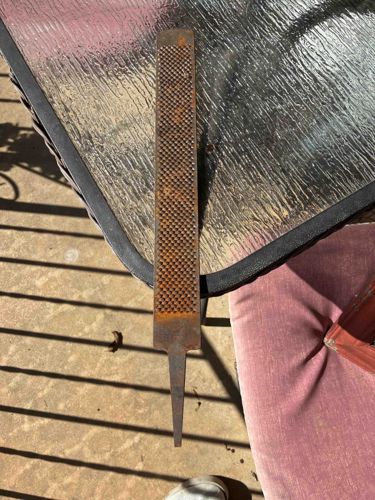
Flat Metal Rasp
The item is a flat metal rasp, appearing to be constructed from steel or a similar ferrous alloy, given its reddish-brown coloration indicative of rust. It measures approximately 10 to 12 inches in total length based on its proportion to the surrounding objects. The working surface of the rasp is rectangular, featuring a coarse, double-cut, or 'stitch' pattern of raised teeth. These teeth are arranged in a crisscross or diamond-like pattern, designed for aggressive material removal from softer materials like wood, plastic, or even some metals. The rasp's color is predominantly rust-brown, with some darker areas suggesting heavier corrosion or accumulated grime, and possibly remnants of original darker steel. The head of the rasp, where it would typically meet a handle, tapers down to a narrower tang, which is the part that would be inserted into a wooden or plastic handle (which is absent in this image). The entire metal surface shows significant signs of wear and age, including extensive surface rust across the working face and the tang. There are no visible manufacturer's marks, stamps, or signatures, likely obscured by the rust or general wear. The item appears to be an older, utilitarian hand tool, estimated to be from the mid-20th century or earlier, given its robust construction and visible patina. Its condition indicates it has been stored in a damp environment or neglected for some time, leading to the pervasive rust. Despite the rust, the fundamental structure of the teeth appears intact, suggesting it could still be functional after cleaning and potentially sharpening. The craftsmanship is typical of industrial tool manufacturing, focusing on durability and utility rather than decorative elements.
AI-Generated Appraisal Disclaimer
Estimated Value
$5 - $15
Basic Information
Category
Hand Tool
Appraised On
December 21, 2025
Estimated Value
$5 - $15
Item Description
The item is a flat metal rasp, appearing to be constructed from steel or a similar ferrous alloy, given its reddish-brown coloration indicative of rust. It measures approximately 10 to 12 inches in total length based on its proportion to the surrounding objects. The working surface of the rasp is rectangular, featuring a coarse, double-cut, or 'stitch' pattern of raised teeth. These teeth are arranged in a crisscross or diamond-like pattern, designed for aggressive material removal from softer materials like wood, plastic, or even some metals. The rasp's color is predominantly rust-brown, with some darker areas suggesting heavier corrosion or accumulated grime, and possibly remnants of original darker steel. The head of the rasp, where it would typically meet a handle, tapers down to a narrower tang, which is the part that would be inserted into a wooden or plastic handle (which is absent in this image). The entire metal surface shows significant signs of wear and age, including extensive surface rust across the working face and the tang. There are no visible manufacturer's marks, stamps, or signatures, likely obscured by the rust or general wear. The item appears to be an older, utilitarian hand tool, estimated to be from the mid-20th century or earlier, given its robust construction and visible patina. Its condition indicates it has been stored in a damp environment or neglected for some time, leading to the pervasive rust. Despite the rust, the fundamental structure of the teeth appears intact, suggesting it could still be functional after cleaning and potentially sharpening. The craftsmanship is typical of industrial tool manufacturing, focusing on durability and utility rather than decorative elements.
Related Tags
Explore similar items and categories:
Get Your Items Appraised
Instant estimates of your treasures with AI-powered instant appraisals